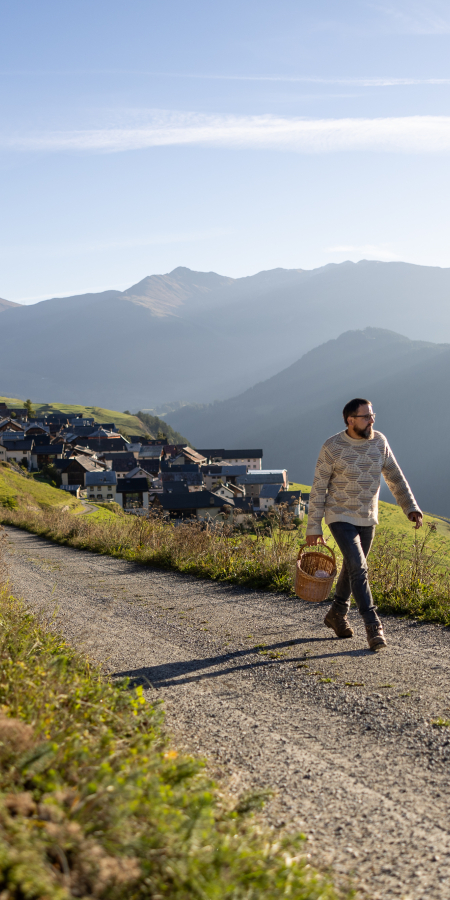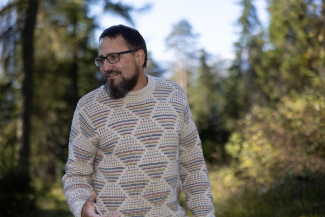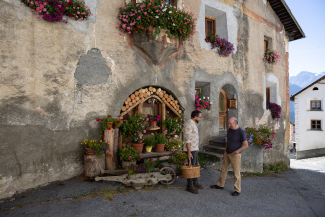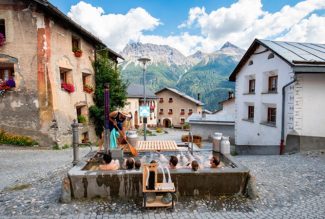Curdin Tones
Always follow your nose

If you start to smell consciously, you will be surprised at how rich the landscape smells and tastes.
Curdin Tones Artist

Curdin Tones wanders through the forest above Tschlin, carrying a woven basket in his hand. He uses it to go picking, but not mushrooms or berries, at least not exclusively. He is interested in the forest as a whole, with all its plants, inhabitants, materials and substances.


A bit like cinnamon
He sniffs grasses, twigs, logs and roots. And if his nose notices something, he rubs it in his hand and tastes it with his tongue. «This larch bark tastes amazingly berry-like, a bit like cinnamon,» he says.


In this way, he collects tree bark and resin, fresh needle shoots and leaves, as well as dung from deer and ibex. He later processes the collected materials into fine powders, which are stored in countless jars in his house in Tschlin. He uses them to make incense sticks or scented sprays for his art events and cultural projects.
Always local and with people
Curdin Tones is an artist who works in a social context, who goes out to the people, into the village, into nature and is interested in and committed to social coexistence. His projects and activities always have a strong local connection. To Tschlin, the Engadin and the Alpine region in general.

Engadine smoking sticks
He is happy when he can show his audience something new or surprising. An emancipatory approach – that people can learn something and experience it for themselves – is important to him. That's why he organises workshops where people can collect their own ingredients in the forest and make Engadine incense sticks from them.


Somalgors 74
Curdin founded the Somalgors74 cultural initiative in Tschlin in 2017. The cultural initiative first attracted attention with an oversized QR code that Curdin had scratched onto the wall of his house as sgraffito. With the corresponding app, you can call up digital sgraffito ornaments as augmented reality.

Augmented reality experience in Tschlin
The QR code on the façade can be scanned using the «Fatschadas» application.
Connecting worlds
Curdin likes to combine worlds: Tradition and modernity, past and future, urban and rural. He is interested in social change in the local context and what it does to people. This is how the «Bügl Public» project came about, which combines today's wellness pleasures with the former fountain community.
Wellness in the village fountain
This summer, the village fountains in Scuol and Ftan are once again hosting public fountain baths. The water is heated by a wood-burning stove, while a reclining grate and whirlpool pump provide pure relaxation. The aim is to revitalise the village fountain as a social meeting place.

Our consciousness only switches on when we are surprised by an odour.
The underestimated nose
Recently, Somalgors74 has been intensively exploring the sense of smell, breaking new ground and arousing curiosity. For Curdin, the nose is an underestimated sensory organ: «We think that we humans can only smell badly, but we can do it quite well when we start to consciously perceive what we smell.»
«Adüna davo il nas»
This is exactly what he wants to convey to people: That they learn to perceive the landscape of the Engadin not only with their eyes and ears, but specifically with their nose, so that they can immerse themselves in a new and extremely diverse world. «Adüna davo il nas» - «Always follow your nose» is the name of this practical and instructive workshop, which Curdin has developed in collaboration with the Swiss Foundation for Landscape Conservation and artist friends.



The participants receive instructions and techniques for consciously smelling. For example, the group kneels down to sniff and sniff directly on the forest floor or at knee height. In other words, in the area where a dog or fox moves, which constantly analyses odours. But that's just warming up the nose, says Curdin. A more complex exercise is to find the «olfactory panorama»: a point in the landscape where a particularly large number of good odours come together.
Visually controlled human
Curdin says: «As upright humans, we are visually controlled and usually only perceive odours unconsciously. Our consciousness only switches on when we are surprised by an odour: when it burns. When it stinks or smells particularly foul. When I enter a strange house or recognise a familiar smell. That's why people have the feeling that they don't smell good.»

I have always felt very connected to Tschlin.
Smell of hay and cow dung
Odours are processed in the emotional part of the brain and can also be stored as memories. Curdin, for example, can well remember what it smelled like in Tschlin when he got off the Postbus as a boy. «A subtle but omnipresent scent of sweet cow dung and hay wafted towards me.» Little Curdin liked this smell, he found it fragrant and not pungent like on the farms in the lowlands.

Archive of alpine odour memories
But today it no longer smells like that in Tschlin, says Curdin. «The cows no longer live directly in the village, but outside in large barns where they are fed like in the lowlands, not only with hay but also with silage. The odour quality of the past has unfortunately been lost.»
Curdin has therefore been looking for ways to materialise olfactory memories and share them with other people. In his «archive of alpine olfactory memories», you can spray scented sprays on objects or burn incense sticks - and breathe in the former hay and cow dung smell of Tschlin for real. Or the smell of a blackened kitchen in an old Engadine house. Or the smell of goat milking... In total, around ten alpine odour memories from various people have been archived.




Zurich, Amsterdam, Tschlin
Curdin has had close ties with Tschlin, his father's home, since he was a child. Although he went to school in the Zurich conurbation, he grew up for the most part in the sunny Engadin village. After secondary school, he studied art in Amsterdam, where the 48-year-old still lives today. However, he has always been a regular visitor to Tschlin. And since he bought a house and began to work more context-specifically, he has increasingly shifted the centre of his life to the Lower Engadine.
He loves the magnificent landscape, the unspoilt nature, his vegetable garden, the simple mountain hut built by his great-grandfather, the Romansh language and the good friendships in the village community. «I've always felt very connected to Tschlin.»
Connecting worlds
But he also likes the urban environment and the cultural melting pot of a big city like Amsterdam. This is where his understanding as a mediator and connector of different worlds comes from. «I've always held a kind of intermediate position from which I like to create things.»
Text: Franco Furger, Picture: Dominik Täuber, Video: OnAir AG





